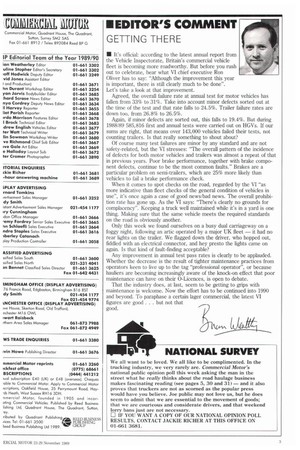GETTING THERE
Page 5

If you've noticed an error in this article please click here to report it so we can fix it.
• It's official: according to the latest annual report from the Vehicle Inspectorate, Britain's commercial vehicle fleet is becoming more roadworthy. But before you rush out to celebrate, hear what VI chief executive Ron Oliver has to say: "Although the improvement this year is important, there is still clearly much to be done". Let's take a look at that improvement.
Agreed, the overall failure rate at annual test for motor vehicles has fallen from 33% to 31%. Take into account minor defects sorted out at the time of the test and that rate falls to 24.5%. Trailer failure rates are down too, from 26.8% to 26.5%.
Again, if minor defects are sorted out, this falls to 19.4%. But during 1988/89 585,816 first and annual tests were carried out on HGVs. If our sums are right, that means over 143,000 vehicles failed their tests, not counting trailers. Is that really something to shout about?
Of course many test failures are minor by any standard and are not safety-related, but the VI stresses: "The overall pattern of the incidence of defects for both motor vehicles and trailers was almost a repeat of that in previous years. Poor brake performance, together with brake component defects, continue to be the most common faults." Brakes are a particular problem on semi-trailers, which are 25% more likely than vehicles to fail a brake performance check.
When it comes to spot checks on the road, regarded by the VI "as more indicative than fleet checks of the general condition of vehicles in use", it's once again a case of good news/bad news. The overall prohibition rate has gone up. As the VI says: "There's clearly no grounds for complacency". Keeping a truck well maintained while it's in a yard is one thing. Making sure that the same vehicle meets the required standards on the road is obviously another.
Only this week we found ourselves on a busy dual carriageway on a foggy night, following an artic operated by a major UK fleet — it had no rear lights on the trailer. We flagged down the driver, who hopped out, fiddled with an electrical connector, and hey presto the lights came on again. Is that kind of fault-finding acceptable?
Any improvement in annual test pass rates is clearly to be applauded. Whether the decrease is the result of tighter maintenance practices from operators keen to live up to the tag "professional operator", or because hauliers are becoming increasingly aware of the knock-on effect that poor maintenance can have on their 0-Licences, is open to debate.
That the industry does, at last, seem to be getting to grips with maintenance is welcome. Now the effort has to be continued into 1990 and beyond. To paraphase a certain lager commercial, the latest VI figures are good. . . but not that good.




































































































































































